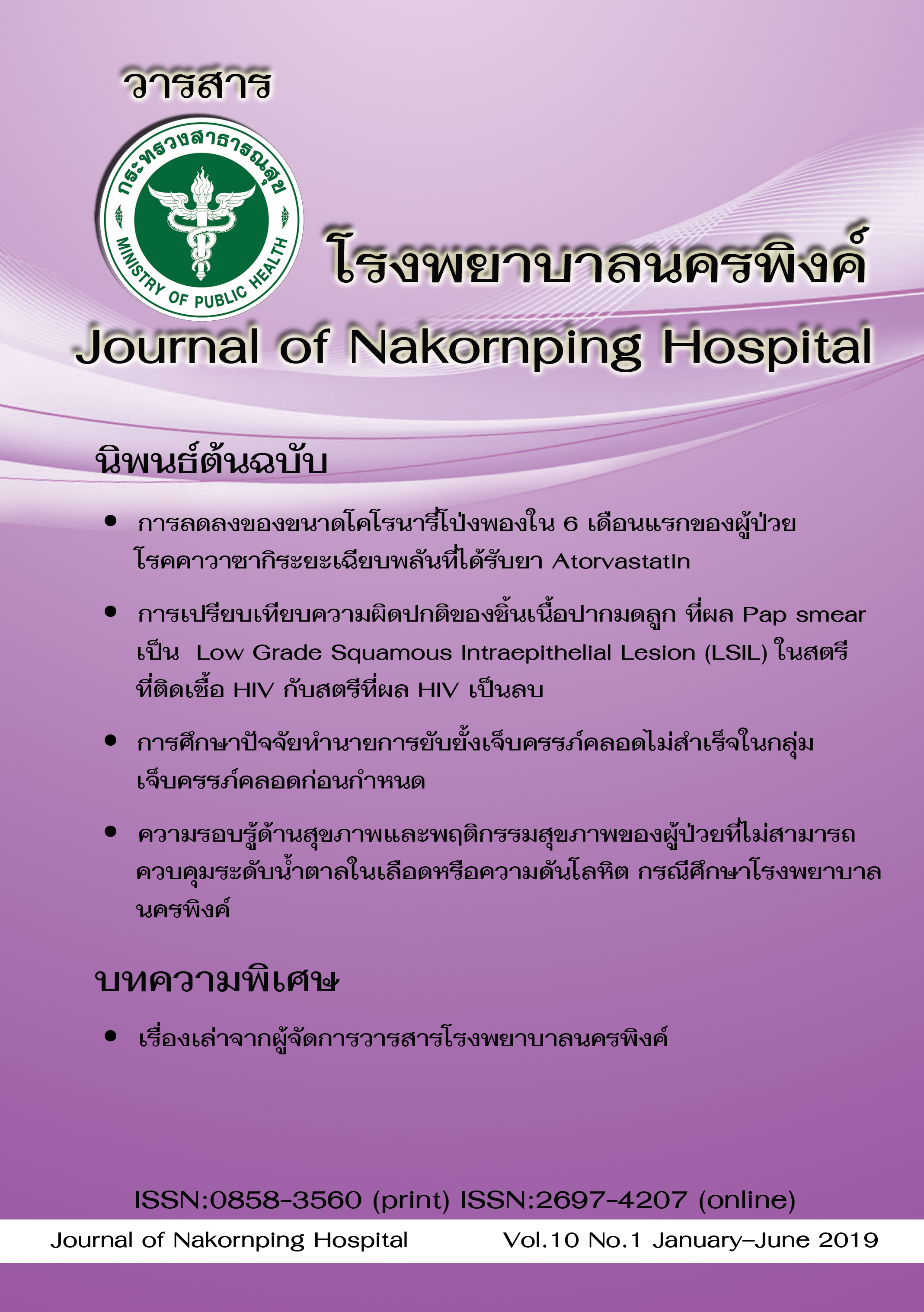Comparison of the cervical pathologic results in Low-Grade Squamous Intraepithelial Lesion (LSIL) cervical smear between HIV positive and HIV negative women
Keywords:
HIV positive, Pap smear, Prevalence, Cervical cancer, colposcopyAbstract
Objective: To determine the prevalence of abnormal cervical pathologic results from cervical tissue biopsy in women who had abnormal Pap smear LSIL, compared between HIV positive and HIV negative women.
Design: Retrospective Cross-sectional study
Background: Abnormal cervical lesion Low-Grade Squamous Intraepithelial Lesion (LSIL) may progress to High-Grade Intraepithelial Lesion which is a precursor of invasive cervical cancer. According to previous data, the prevalence of Abnormal cervical lesion in HIV positive women was estimated high and may progress to invasive cervical cancer more rapidly. Therefore, early detection of the abnormal cervical lesion could be useful for early treatment and reduce the incidence of invasive cervical cancer. This study aims to determine the prevalence of abnormal cervical pathology in LSIL cervical smear between HIV positive and HIV negative women.
Subjects: The 265 women with LSIL from Pap smear results who underwent colposcopic work up at Nakornping Hospital from October 2015 to September 2018. The study group was 60 HIV positive women and the comparative group was 205 HIV negative women.
Methods: The data were collected from medical records of colposcopic clinic Nakornping Hospital. The women who had LSIL from Pap smear and underwent cervical tissue biopsy due to abnormal colposcopic finding were included in this study. Pathologic results were explored to determine the prevalence and severity of the cervical abnormality. All associated data were compared between HIV positive and seronegative women
Results: HIV positive women with LSIL from Pap smear had a prevalence of abnormal cervical cell more than the prevalence of cervicitis or normal tissue. HIV infected women had LSIL from cervical tissue biopsy more than the HIV negative group significantly (Relative risk ratio 2.49, 95% Confident interval 1.29-4.78, p = 0.006). The prevalence of non-malignant pathologic results (Normal, Cervicitis) and high-grade lesion (HSIL, Carcinoma) was not different between the two groups.
Conclusions: Women with LSIL from Cervical smear should undergo colposcopic work up to identify actual abnormal cervical lesion especially HIV positive women who frequently had abnormal cervical tissue.
References
2. National Cancer Institute, Thailand. The leading site of new cancer patient in female. Hospital-base registry annual report 2017. 2018; 3.
3. Pengsa P, Jindawijak S. Cervix uteri. In: Sriplung H, Sontipong S, Martin N et al, Cancer in Thailand 2003; Vol. IV, 1998-2000 Bangkok: Bangkok Medical Publisher, 49-50.
4. Cervical Cancer Incidence, Mortality and prevalence worldwide in 2008: Summary. http://globocan.iarc.fr/factsheet.asp (Accessed on June 30, 2019).
5. WHO/ICO Information Center of HPV and Cervical Cancer (HPV Information Center). Human Papillomavirus and Related Cancers in the World. Summary Report 2010. http://www.who.int/hpvcentre/en/ (Accessed on June 30, 2019).
6. Nasiell K, Roger V, Nasiell M. Behavior of mild cervical dysplasia during long-term follow-up. Obstet Gynecol 1986; 67: 665-669.
7. Mandelblatt JS, Fahs M, Garibaldi K, Senie Rt, Peterson HB. Association between HIV infection and cervical neoplasia: implication for clinical care of women at risk for both conditions. AIDS 1992; 6: 173-8.
8. Patanasakpinyo C, Roungchaisareepong S, Sangmanee S, Kongnil N, Klomklao S. Pap smear in women infected with HIV in Sawanpracharak hospital. Sawanpracharak Medical Journal 2009; 6:2: 107-116.
9. Vafaei H, Asadi N, Foroughinia L, Salehi A, Kuhnavard S, Akbarzadeh M, Ravanbod HR, Mohamadalian F, Kasraeian M, Comparison of Abnormal Cervical Cytology from HIV Positive Women, Female Sex Workers and General Population. IJCBNM. 2015;3(2):76-83
10. Prabha Devi K, Bindhu Priya N. Conventional Pap Smear Screening in HIV Seropositive Women in South India. J Ostet Gynaecol India 2013; 63:55-8
11. Splitz M, Brennessel D, Seltzer VL. Is human Papilloma virus-related disease an independent risk factor human immunodeficiency virus? Gynecol Oncol 1993; 49: 243-6.
12. Khuakoonratt N, Tangjitgamol S, Manusirivithaya S, Khunnarong J, Pataradule K, Thavaramara T, Suekwattana P. Prevalence of High Grade Squamous Intraepithelial Lesion (HSIL) and Invasive Cervical Cancer in Patients with Low Grade Squamous Intraepithelial Lesion (LSIL) at Cervical Pap smear. Asian Pacific J Cancer Prev 2008;9;253-258.
13. Chaivirattana S, Lomdee T, Histological Diagnosis of Conventional Pap Smear with Low Grade Squamous Intraepithelial Lesion (LSIL) in Chonburi Hospital. Thai J Obstet Gynaecol 2012; 20:34-40.
14. Suwankanta N, Kietpeerakool C, Srisomboon J, Khunamornpong S, Siriangkul S. Underlying Histopathology of HIV-infected Women with Squamous Cell Abnormalities on Cervical Cytology 2009. Asian Pacific J Cancer Prev, 9, 441-444.
15. Heard I, Tassie JM, Schmitz V, et al. Increased risk of cervical disease among human immunodeficiency virus- infected women with severe immunosuppression and high human papillomavirus load. Obstet Gynecol 2000;96, 403-9.
16. Davis AT, Chakraborty H, Flowers L, et al. Cervical dysplasia in women infected with the human immunodeficiency virus (HIV): a correlation with HIV viral load and CD4+ count. Gynecol Oncol 2001; 80, 350-4.
17. Massad L S, Einstein M H, Huh K W, Katki H A, Kinney W K, Schiffman M, Solomon D, Wentzensen N, Lawson H W. 2012 Updated Consensus Guidelines for the Management of Abnormal Cervical Cancer Screening Tests and Cancer Precursors. Journal of Lower Genital Tract Disease 2013;17: 5, S1-S27.
Downloads
Published
How to Cite
Issue
Section
License
The articles that had been published in the journal is copyright of Journal of Nakornping hospital, Chiang Mai.
Contents and comments in the articles in Journal of Nakornping hospital are at owner’s responsibilities that editor team may not totally agree with.



